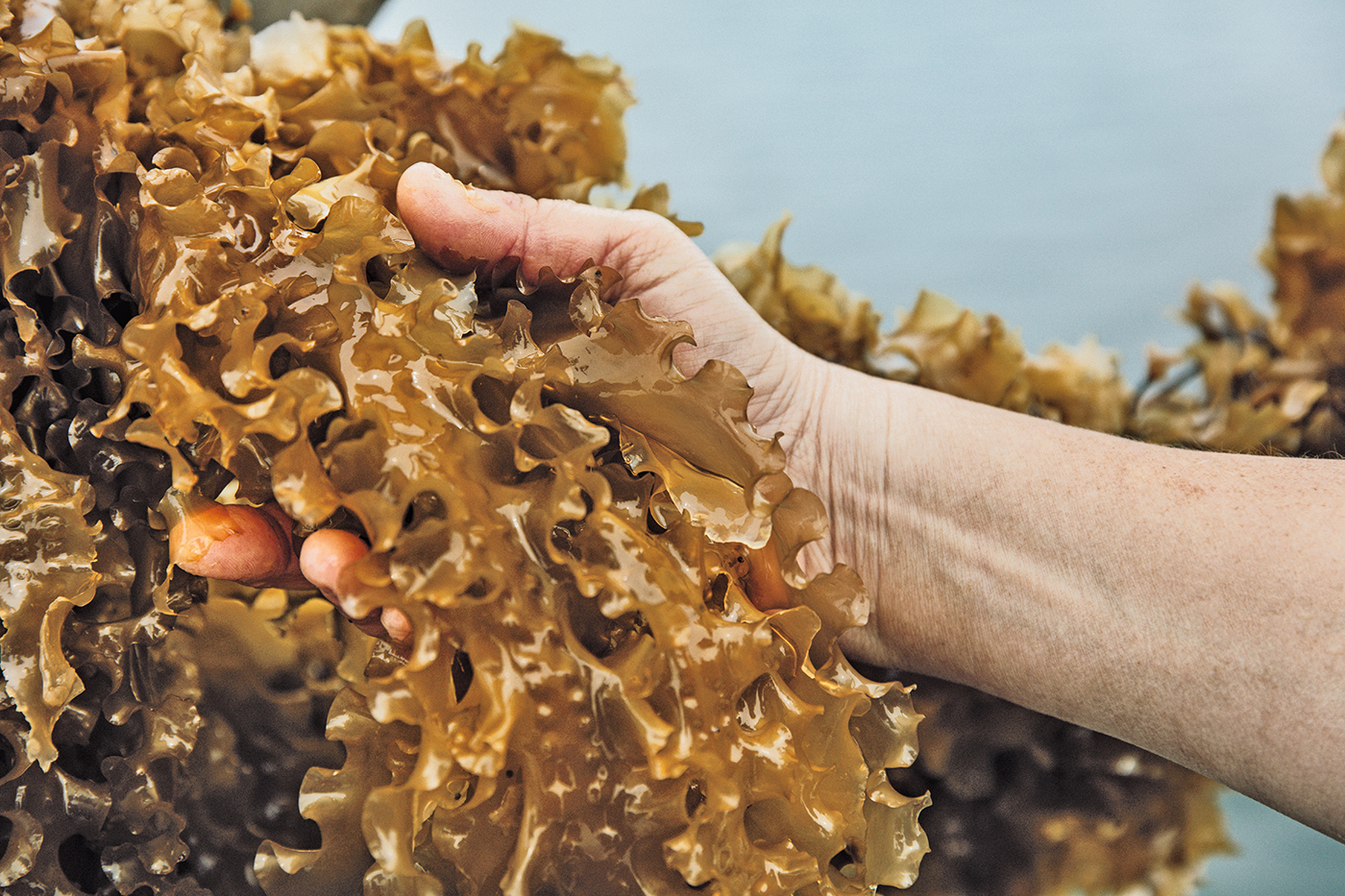Kelp On The Cusp
Powdered, Pickled, or Brewed, the Savory Seaweed May Finally Be Having Its Moment
By Ellen Liberman| Photographs by Jesse BurkeCatherine Puckett’s kelp farm spans 2 and a half acres of Block Island’s Great Salt Pond. Eight longlines, suspended between moorings more than 500 feet apart, support her crop, undulating just beneath the water’s surface. On this April afternoon, the water is a clear emerald green as Puckett casts off and pilots her distinctive teal and chalk-pink work boat from the Inner Basin of the Great Salt Pond, known locally as the Hog Pen.
New England Kelp Harvest Week has just gotten underway, and Puckett is racing to harvest 50 pounds of kelp in time for the 2 p.m. New England Airlines flight to the Westerly Airport, where Suzie Flores, who—with her husband, Jay Douglas—owns the Stonington Kelp Company, will pick it up for the festival’s cooking demonstrations. This is Puckett’s fourth season farming kelp, part of a collection of sidelines familiar to many aquaculturists that adds up to a living. She motors past her 1-acre clam and oyster lease to the starboard and cuts the engine about a mile off Beane Point.
The daughter of a boat builder, Puckett was raised on the water, and she is doing the same for her daughters, Pearl, 7, and Luna, 5, who round out the crew. Puckett’s interest in seaweed was born about the same time as her eldest child. She had just bought the Block Island Oyster Farm, where she had worked for 13 years, and a fervor for healthy eating had taken hold.
“Maybe it happened as I was walking the west-side beaches with my baby,” she says, “But I had this powerful feeling that I wanted to grow seaweed. I went on a tear—I was buying seaweed online and cooking and experimenting with it and ordering stacks of books from the library about seaweed.”
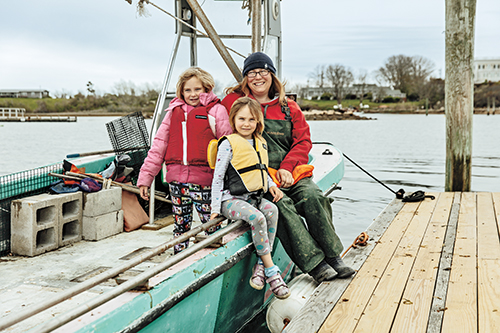
Catherine Puckett and her daughters Pearl and Luna harvest kelp together on a chilly spring day.
Five years ago, a casual conversation with a neighboring oyster farmer connected Puckett to GreenWave, a Connecticut-based nonprofit that helps prospective kelp growers with technical assistance, free seed, and connections to kelp buyers. After a year of education and permitting, Puckett put in her first crop. She hauls up a heavy golden curtain of Saccharina latissima and admires the sugar kelp’s ruffled fronds.
“Isn’t it beautiful? I love the way it sparkles in the sunshine!”
There isn’t actually much time for wonder. Harvesting is a low-tech enterprise featuring scissors or knives, slicing the stipe [the stalk of the seaweed] from the long line at speed. Highly perishable and temperature-sensitive, kelp must be kept cool on its way to a processor or a plate. The trio switches off cutting and bagging. Pearl and Luna clamor for a turn with the scissors, while their mother gently urges them along: “We’ve got a plane to catch!”
This afternoon is one in a succession of small harvests over five weeks before her lease is up at the end of the month.
“Growing kelp is such a joy,” she says. “I put it out there in October and November, and I get to go out on my boat on the most glorious winter days, check my lines, and watch it grow. From this fuzzy line, you have these 2-inch plants and then a foot or two of kelp. In the spring, the growth is exponential. Every other week it doubles in size—it’s really fun to watch. Kelp is the local-est, healthiest, environmentally positive food, and when I pull it up, I just love it so much. That connection with the ocean makes me so happy. It must have been the feeling that I was looking for.”
Humans have been harvesting seaweed for centuries. They have eaten it, distilled it, composted it, and extracted its nutrients, fiber, and trace minerals for a wide array of uses. In 2020, the World Health Organization reported that 32.4 million tons of marine macroalgae was farmed. Globally, market research firms have valued the commercial seaweed industry at more than $14 billion in 2020. Yet, in the U.S., its footprint has been small. Seaweed aquaculture barely registers on the U.S. agricultural census, conducted by the U.S. Department of Agriculture (USDA) every five years. The 2018 report tallied only four farms—a significant undercount. The USDA’s National Agricultural Statistics Service does not even include seaweed aquaculture production in its statistical data.
Dr. Charles Yarish, a University of Connecticut professor emeritus of evolutionary biology and ecology who has been conducting seaweed aquaculture research and development, says he knows of at least 40 kelp farms off the northern waters on both U.S. coasts and in Alaska, but there is no state-by-state tally marking the last decade’s revived interest in kelp.
A consortium of researchers, farmers, chefs, marketers, and processors has been trading ideas, developing better farming and harvesting practices, and making plans to put kelp on as many plates and in as many products as possible.
“People want a good healthy product that’s readily traceable, but I think we still have a way to go in getting more public acceptance,” Yarish says. “It is still a work in progress. It took a long time. Humans have been using seaweed for 15,000 years, and here we are in the last 70 years in an expansion of seaweed agriculture outside of Asia.”
An Ancient Bond
“Kelp” is a very old word for an even older plant species. Marine algae (seaweed) show up in the fossil record dating back a billion years. Scientists have specifically documented kelp, a brown alga, in the Miocene Epoch, 23 to 5 million years ago. The name’s origin is unknown, but “kelp” came into existence in the 16th century to describe the ashy remains of burnt seaweed, which was used in soap and glassmaking.
The archaeological record has established kelp’s presence in the diets of ancient Hawaiians, Icelanders, and Scottish sheep. And anthropologists now theorize that the first humans did not enter the North American continent via a land bridge over the Bering Strait.
Humans have been using seaweed for 15,000 years, and here we are in the last 70 years in an expansion of seaweed agriculture outside of Asia.
Rather, they arrived 16,000 years ago by boat, travelling from the Pacific Rim along the Kelp Highway to the Americas, sustaining themselves, in part, by using the underwater forests along the Pacific coast as a food source.
“It started 11,000 years ago. There was a population on the California islands, [and] we have archaeological evidence of them using seaweed in the kitchen—actually cooking it and eating it,” says Michael Graham, a professor at San Jose State University’s Moss Landing Marine Laboratories and editor of an academic journal about kelp, who has written about its history. “The knowledge gap between 11,000 years ago and now is pretty big.”
In 1811, French chemist Bernard Courtois was searching for a new source of potassium nitrate, after the gunpowder demands of the long-running Napoleonic Wars had depleted the stores of wood ash from which the key ingredient—potassium—was extracted. Courtois turned to kelp residue, and in the process, became the first to isolate iodine.
A century later, kelp was again in demand as the raw material of ordnance. Germany, which controlled the world’s largest supply of mineral potash, had stopped exports after the start of World War I, founding a brief but successful potash manufacturing industry using California giant kelp. The U.S. was the world’s biggest consumer of potash fertilizer and officials feared that the German embargo threatened the nation’s agricultural production.
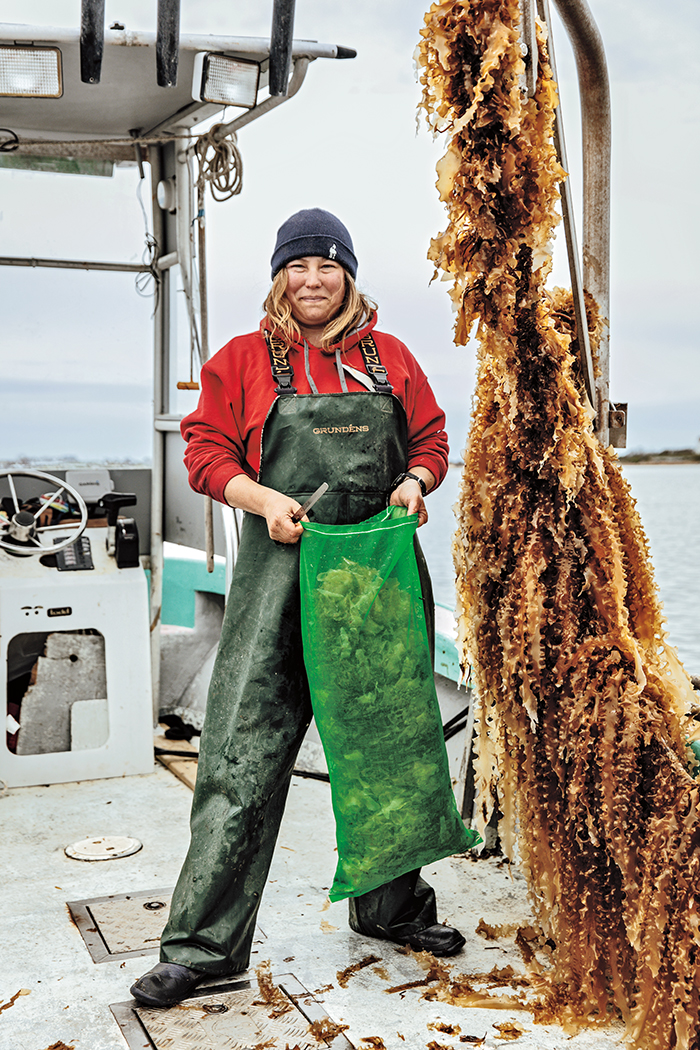
In 1914, 11 commercial kelp harvesters and processors sprang into existence on the California coast. The largest was The Hercules Powder Company, which at the height of World War I was harvesting and processing kelp for potash and acetone, which the British used to manufacture cordite, a smokeless gunpowder.
At the end of World War I, the demand for kelp abruptly stopped, and so did these businesses. An exception was Kelco, which harvested and processed California giant kelp as an alginate—a natural gelling sugar used as a thickener and emulsifier. Founded in 1929, the San Diego-based company eventually employed nearly 800 people and operated a fleet of five kelp-cutter vessels to harvest the beds off Point Loma and La Jolla.
Kelco extracted the algin to produce a line of powders used in 70 different products from ice cream to fabric dye to car polish. Kelco, sold and merged with a Dutch company, shut down its California operations in 2006. But turning kelp into alginate is now a global industry. In the century since the Armistice, kelp aquaculture in the U.S. has proceeded in fits and starts, with small pilot projects dotting the coasts, as researchers studied kelp’s potential as a biofuel and as a food. But each effort was stymied by a variety of obstacles, ranging from regulatory to public interest.
In the wake of the 1970s oil crisis, the U.S. government launched a research and development effort to develop kelp as an energy source. Under the Marine Biomass Program, the government developed and operated offshore kelp farms in New York and California in hopes of converting their biomass to methane. The program was discontinued after a dozen years. As a cheap energy source, kelp could not compete with fossil fuel, which geologists were sure was in plentiful supply. In 2017, the U.S. Department of Energy resumed its pursuit of seaweed as a biofuel, distributing $22 million in federal funds to 18 projects.
The Biomass Program laid the groundwork for today’s aquaculturists growing kelp for food. Each small open-ocean kelp farm helped advance growing and harvesting techniques and equipment, leading to the first U.S. commercial operation in 2009, Atlantic Sea Farms in Maine. While the number of kelp farms has slowly proliferated in the last decade, experts say there are still substantial knowledge and regulatory gaps to fill.
“We know a lot more about farming kelp than about how to stabilize and process it,” says Samantha Garwin, GreenWave’s market innovation strategist.
“There’s a lot of unknowns around basic things—we don’t know the best holding temperature or even the container that is the best for extending the shelf life of kelp.”
It’s an article of faith that kelp is good for the body and the environment (kelp absorbs carbon dioxide and releases oxygen), but exactly how is the subject of a lot of research: quantifying kelp’s benefits as a soil amendment, developing it as an alternative to plastics, or identifying its properties as a health supplement.
“The infrastructure for production is underfunded, and until it gets to that point and seaweed is being produced everywhere, it won’t be priced [low enough] to be better utilized. That’s the point where people will be looking at it nutritionally,” says Graham, who also raises seaweed in land-based, 1,000-gallon tanks as Monterey Bay Seaweeds, and sells his fresh, raw product to high-end restaurants—including the Matunuck Oyster Bar. Government agencies, including the USDA, the National Oceanic and Atmospheric Administration (NOAA), and the Food and Drug Administration (FDA), have begun to invest heavily in seafood aquaculture, and Graham says, “We’re just starting to do the science on the nutritional side, so that we can come to that chef with the facts and say, ‘Look this is a low-carb, high protein food with these nutritional elements—this is why it’s good for your clients.’ We’re not there yet.”
Nor are there adequate safety standards governing seaweed as a food product, says Dawn Kotowicz, a coastal research associate with the University of Rhode Island’s Coastal Resources Center and extension specialist with Rhode Island Sea Grant. Right now, seaweed falls in between the FDA, which regulates seafood safety, and the USDA, which sets federal organic standards—neither covers the sale of seaweed in its whole form. This uncertainty has slowed the development of state permitting rules. For example, New York State “allows kelp farming on specific bays, but it’s not allowed in a broad way because there is no detailed federal guidance,” she says. “Each individual state needs to develop their own. There’s not a lot of consensus.”
Farming on a String
In 2010, David Blaney retired from going to sea. A commercial fishing boat captain, marine surveyor, and safety consultant, he pursued a degree in marine affairs to prepare for his next career. He was working in a URI lab on eelgrass habitat restoration, when the research project leader “ripped up a handful of eelgrass. He took a bite—‘You can eat this stuff.’ I knew it was good on gardens and things. That really piqued my interest, although it took years for it to bubble to the top. I kept hearing more and more about cultivating seaweed.”
Like most new kelp farmers in southern New England, he eventually connected with Yarish and GreenWave.
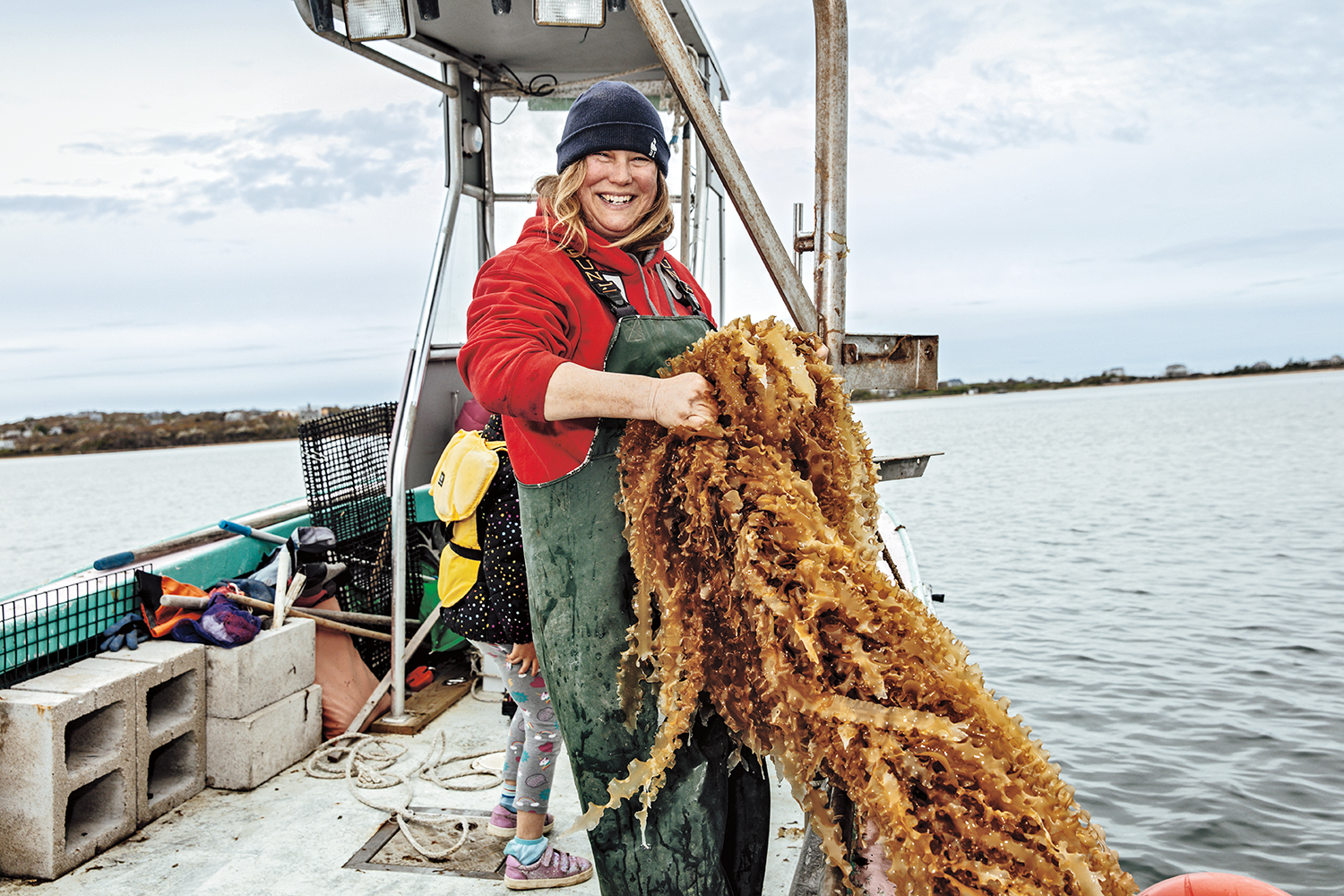
Puckett sees kelp as a way to practice restorative ocean farming, promoting healthy ecosystems.
The latter, founded by commercial fisherman Bren Smith in 2014, advocates a polyculture farming system that utilizes the entire water column with vertical layers of seaweed and shellfish, for maximum yield and sustainability with zero inputs. In seven years, GreenWave has trained more than 700 kelp farmers in its regenerative farming methods and maintains a waiting list of 8,000 applicants from all over the world.
Kelp potentially has the biggest environmental and economic impact of any new ingredient out there.
Blaney was intrigued. He put his first crop in the Point Judith Harbor of Refuge in 2015 and produced a couple of tons but ended up “liberating” a lot of it. Over the next five seasons, Blaney refined his production skills. He now makes his own seed string by gathering native wild male and female kelp specimens and spawning new spores in fish tanks with carefully controlled water temperature and light. The operation runs from October, for spore production, to the harvest in May.
On a warm May sunrise, the water is flat calm, and Blaney’s handmade dory is just about the only vessel rippling the surface. This was once one of the busiest and more dangerous points on the East Coast, Blaney says. At the turn of the 19th century, sailing ships and ferries had to take a hard right to continue northward, and the bottom is littered with their failures. Last November, a barge went aground off Point Judith, after the tug towing it sank. The surf pushed the 108-foot barge offshore, and eventually into Blaney’s kelp farm. But, since then, the lines have been righted and re-moored, and his crop has matured nicely.
With the harvest just a week away, Blaney takes a slow turn around the long lines to inspect the growth. The past two seasons saw great yields. But in 2020, COVID closed off the markets, and save for a small portion that Blaney dried in a greenhouse, several tons sank back into the water.
“This year we were approached by a company that will buy the whole crop, and I can retain whatever I want for my own purposes. It’s not about making money right now—I’d like to, but I’m not in it to get rich at this stage of the game. I believe it will be an alternative for the fishing industry, which is stressed by industry pressures,” he says. “It’s all been an experiment to see what works.”
In many ways, kelp’s seasonal cycle is appealing. Farmers stake their lines in the late fall and harvest in the early spring. Then, the gear is collected, vacating the water just in time for the busy recreational boating season. Despite the felicitous timing, it’s hard for newcomers to break in, and kelp remains a tiny portion of the state’s aquaculture portfolio. Benjamin Goetsch, the Coastal Resources Management Council’s (CRMC) aquaculture coordinator, says that Blaney and Puckett work the only independent kelp farms in Rhode Island waters.
“Many oyster farmers in the bay and ponds have kelp as approved species on their permit, but very few of them (if any) are currently producing kelp,” Goetsch said in an email. “Farmers that use floating gear are able to incorporate kelp easily into their operation as they already have long line approved as part of their permit. Oyster farmers often get interested in kelp as a way to diversify their crops and give it a try but do not continue because they do not find it to be a profitable endeavor.”
Azure Cygler, who currently subleases 1.6 acres on an existing oyster farm in the bay’s East Passage, points to the strong and well-organized opposition that has become familiar to prospective shellfish aquaculturists. Last February, Cygler withdrew her application for a 3-acre lease off the Saunderstown Yacht Club, after her preliminary determination hearing before the CRMC drew “dozens and dozens” of opponents claiming that “the bay is filling up with aquaculture.”
“This is what prospective growers are working with right now,” says Cygler, who is also a coastal research associate with the Coastal Resources Center and an extension specialist with Rhode Island Sea Grant. Her small farm is independent from her work at URI.
“It’s practically impossible to get space in Narragansett Bay because of the both real and perceived use conflicts. And it’s a huge challenge for the resource managers. We need to do a better job showcasing the benefits to the economy and the ecology of the bay. For me to scale up, I’m looking in other states.”
Sea Tea and More
Chef Phil Walsh delivers a steaming glass mug of kelp stock to a table of one at Block Island’s Old Island Pub. There’s a smattering of day-trippers seated on the patio; locals hug the bar inside. Walsh slips into a booth to describe his dawning appreciation of the wonders of kelp.
Two years ago, Puckett brought by some of her crop, Walsh recalls.
“When I first got it, I didn’t understand it. I thought: ‘Seaweed—what am I going to do with this?’”
He began to fry it like a chip, pickle it like kraut, and simmer it like a stock. It lent itself well to Asian dishes. He put it in a poke bowl, made it into salad, and processed it into pesto for ravioli. Blanching it turned the golden-brown leaves bright green. “Magic,” he says. This cup holds his vision of a kelp product with mass appeal—a savory broth, rich and protein-y like chicken, that leaves a bit of salt lingering on the tongue. Walsh and Puckett want to brew it, box it, and sell it as designer health water under the name Sea Tea.
He returns to the kitchen to whip up two more kelp-based side dishes: a creamed kelp and a kelp kimchee, accom- panying a piece of blackened tuna. Puckett’s kelp would be featured later in the season as a special and as a complement to his oyster raw bar.
“I think people will want to try something indigenous, and their curiosity will outweigh their inhibitions,” he says. “There are so many health-conscious people—and this is definitely healthy.”
Kelp’s most ardent advocates know that customer exposure is key to market growth. That was the idea behind the New England Kelp Harvest Week, which celebrated its successful debut in April. Over the last week of the month, Suzie Flores drove all over central Connecticut to deliver 500 pounds of fresh kelp to 50 different restaurants and breweries that put kelp on the menu. The kelp festival also live-streamed cooking and cocktail classes to over 50 ticket holders for each class; its saved versions on YouTube have garnered more than 1,000 views.
Flores and her husband fell into kelp farming in Fishers Island Sound five years ago, as a complementary activity to rehabbing the Mechanic Street Marina on the Pawcatuck River in Connecticut. It checked a lot of boxes for the couple—zero-input farming, a healthy product, environmentally beneficial, and a reason to stay on the water year-round. The only thing it didn’t provide was a profit. Flores, another GreenWave graduate, quickly realized that selling her crop to a kelp processor at $2 a pound, when the cost of labor, fuel, and seed stock added up to about $5 a pound, wasn’t a sustainable business plan.
“I found it got [the] highest price as a direct sale to chefs, who can drive consumer interest in an ingredient in season,” she says. “When they begin to use that ingredient in dishes, they normalize it. Every spring, everyone goes nuts for ramps [wild onions]. Why not kelp? The chefs have the platform—they have a community of foodies who follow them. If chefs are using kelp, it’s a way to elevate a new ingredient, and it’s the first step on the learning curve. If someone else cooks it, you would be more inclined to cook it on your own.”
Flores’ creative approach to market development illustrates another obstacle confronting this first generation of southern New England kelp farmers. Growing is the easy part; everything after that is tricky. Farmers planning one big single harvest require equipment and a crew of cutters to haul out the heavy, wet crop and quickly ferry it from the farm to the dock.
“A logistical nightmare,” says Flores. “Unless you have a huge operation with thousands of dollars in equipment, the average farmer won’t have a way to harvest 10,000 pounds of kelp at once. We have a fork-lift—that’s a fluke. Most farms don’t.”
Puckett recounts a near-disaster in 2017: “I had a buyer who promised to have trucks on the dock and didn’t. I hastily arranged another buyer. But if I hadn’t, I would have been responsible for all that kelp, and that’s a scary prospect.”
Once harvested, where does it go?
The nearest kelp processors are 350 miles away in Maine, where the kelp will be dried and milled into a powder used as a food additive, such as kelp cubes for smoothies, or frozen to eventually be thawed as fresh-cut kelp, or pickled and packed into jars. Those transportation costs eat into the farm price —some farmers balk at selling to processors because there isn’t enough financial return. Others don’t like wiping out kelp’s environmental benefits by trucking their crop long distances. “Kelp is the new kale—they’ve been saying this for a decade. But there needs to be more processing and more efficiency,” says Kotowicz. In 2019, she conducted a market needs assessment as part of a $1.5 million NOAA grant to a consortium of Sea Grant programs. The lack of local processing facilities, she says, is a “real stumbling block.”
“It’s a chicken and egg problem. We’ve done consumer surveys showing that lots of people would like to consume seaweed, but are unsure how. We need to produce enough to get it in front of enough people who say they are interested in consuming it. But transporting wet seaweed is really hard; it doesn’t make a lot of sense to truck a barrel of kelp to Maine. At scale, growing and marketing seaweed could be very lucrative, but we haven’t seen that scale in southern New England.”
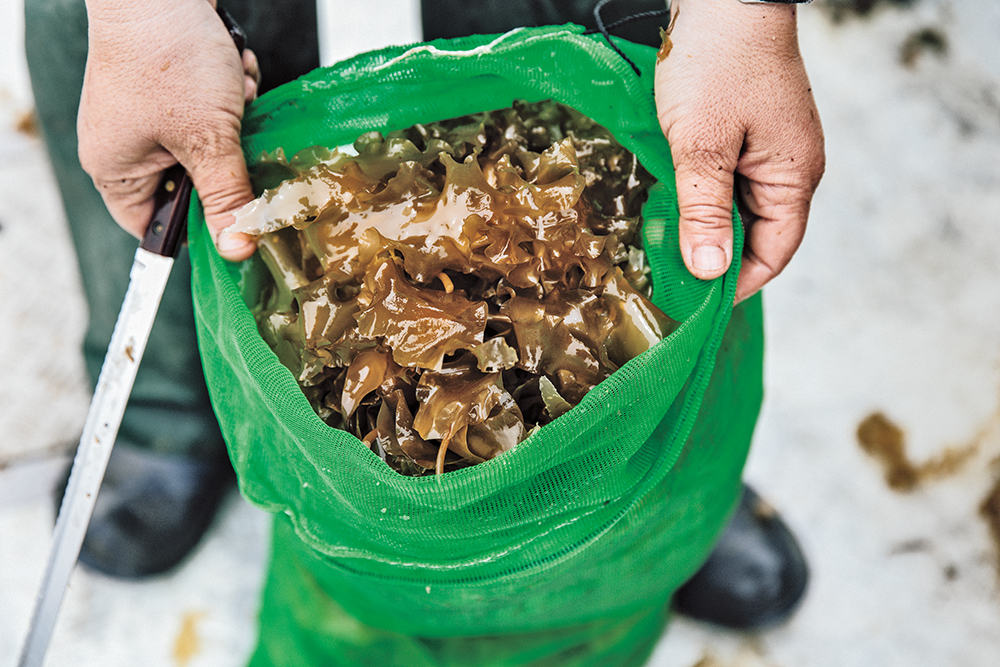
She says that strengthening this link in the market chain is critical, otherwise “there’s the potential for people to lose interest and the motivation to go away.” Casey Emmett, co-founder of The Crop Project, a kelp processing company, jumped into the industry in 2019, after a decade in the natural food business.
“Kelp potentially has the biggest environmental and economic impact of any new ingredient out there. But we need to connect the dots. The processing and logistics problems are similar to other new ingredients that need a lot of help, so it was a good place to start a business. It’s still really early in the industry. It’s going to take another couple of years to get to scale, but you have a lot of people working really hard on this issue, and I have total faith.”
Blaney, who has been drying as much of his crop as he can sell in a rented greenhouse, is now “working feverishly to develop our own processing plant so we can expand the farmer base for kelp.”
In her role as an aquaculturist, Cygler is investigating how kelp farmers can qualify for the federal carbon credit program, so they can make a second stream of income selling carbon credits to other businesses. Meanwhile, funded by a USDA grant, GreenWave is working on developing other independent marketing channels.
One option is to determine if other types of seafood processors could integrate kelp into their existing operations, says Garwin.
“It’s a brand-new crop, and the regulations and supply chains are just being formed,” she says. We have an opportunity to learn from the mistakes made in land-based agriculture and not make them for ocean farming. We need different options for kelp farmers of all sizes.”
This season, Blaney sold his entire yield to The Crop Project. On an unseasonably hot afternoon, a rented refrigerated 18-wheeler idled at the curb of Great Island Road, waiting to whisk several tons into the trailer for the trip up to the company’s drying facility in Biddeford, Maine.
Puckett, intent on keeping her kelp on Block Island, used most of her crop to amend the soil of her vegetable garden. Right now, the industry is thrumming with creative energy—there seem to be at least two ideas about boosting kelp’s profile for every one person in the industry.
“The whole industry is just getting going,” says Puckett. “Everyone is trying to find our market, find our niche.”
Contact Us
Telephone: (401) 874-6805
Email: allard@uri.edu
Contributor Guidelines
Please review submission guidelines to be considered. d

